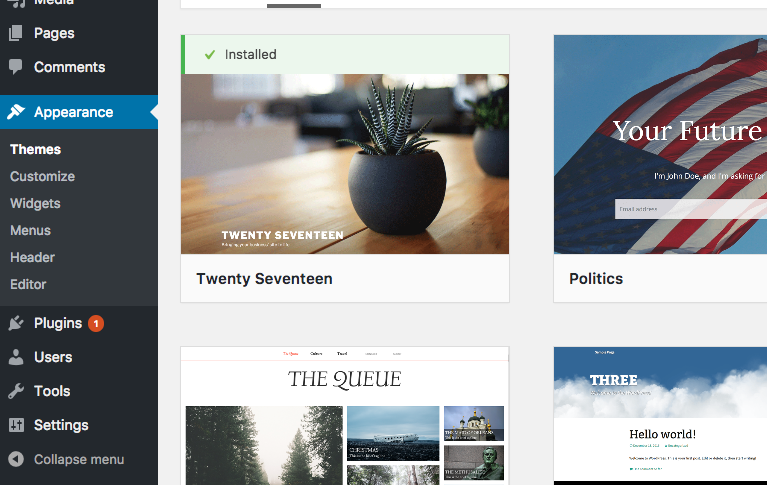Ready to finish up our look at the backend of WordPress and all the common options you can use to administer your site through the Dashboard? Great, let’s jump into it!
Just as a reminder, any plugins you have installed are likely to add additional menu items beyond what we’re covering here.
Appearance
Themes – Want to change the theme your WordPress website uses? This is where you go to do that. You can also search your installed themes or add a new one either by uploading it directly or by searching the official WordPress Theme Directory.
Customize – This allows you to change a lot of options in your theme, but depends largely on what your theme supports. In other words, different options will be available for different themes.
Widgets – Your theme will have special areas designated as widget areas, which WordPress calls Sidebars. This often includes areas like actual sidebars, columns on your home page, and columns in your footer. This is where you can go to swap out what Widgets are in those Sidebars.
Header – If available, this menu option puts you in the Customize area, but it goes directly to where you can edit header options for your theme.
Editor – Like getting your hands dirty? Comfortable directly editing CSS, HTML, and PHP in the WordPress theme files? Then this is the menu item for you!
Plugins
If you need to see what plugins you have installed, as well as deactivate or delete them, this is the place to do it. You can also add new ones, either by uploading one directly, or by searching the official WordPress Plugin Directory.
And if you like the code Editor under Appearance, that same functionality is available for your plugin files as well.

Users
Want to add a new user? Or maybe delete one? You can do both of those tasks, as well as manage overall users in this section. You can even change the color scheme users see in the Dashboard, including what you see. And some themes will use a biography stored here as well.
Tools
Some common tools are located here. That includes a bookmarklet called Press This that allows you to grab bits of the web and create new posts with them. It also includes common importing and exporting options, though your mileage may vary with those.
Settings
Finally, you have a bunch of under-the-hood settings for WordPress. Some of these are also covered in the Customize section under Appearance.
Here you can do things like change your site title, change the administrative email address, set your timezone, set whether your home page is a static page or a list of articles, adjust a lot of settings for comments, adjust default image sizes, and even change the way your permalinks work.
Of course, with any setting in here, be very careful. As a rule of thumb, if you don’t know what you’re doing, you should probably check with a professional.
Of course, I just happen to be a professional! If you don’t want to mess with any of this yourself, I offer WordPress management as one of my services. Feel free to reach out if you’d like to see if I’m a good option for you or not.